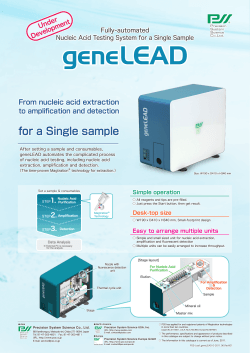
BitNuclease Manual
BitNuclease (Benzonase® Alternative, Purity > 98%) Description BitNuclease is a universal endonuclease that is genetically engineered from Serratia marcescens extracellular endonuclease. It digests both single and double stranded RNA and DNA (in either linear, circular or super coiled form) into 3-5 base fragments, which is below the hybridization limit. BitNuclease has high activity and broad substrate tolerance, making it an ideal enzyme for removal of nucleic acids during protein preparation. It can be added along with cell lysis buffer to eliminate viscosity and increase yields of proteins, including nuclear proteins. Components Contents Cat#:B16002 Cat#:B16003 Cat#:B16012 BitNuclease Purity > 98% 25KU (250U/ul) 250KU (250U/ul) 25KU (25U/ul) Unit definition One enzymatic unit will digest salmon sperm DNA to a ∆A260 of 1.0 (corresponding to degradation of 37µg DNA) in 30 min at pH 8.0 at 37°C. Purity > 98% (SDS-PAGE), endotoxin < 0.22 EU/mg, no protease activity detected. Storage This product can be stored at -20°C for 2 years, or 4°C for 2 months. Should be prevented from freezing. Storage/dilution buffer formula: 50mM Tris-HCl, pH 8.0, 20mM NaCl, 5mM MgCl2, 50% Glycerol. Application 25U/mL 4°C 30-60min Nuclear protein production 100U/mL 37°C 10min or 4°C 30min Virus Purification 12.5U/mL 37°C 30min Vaccine Production 0.9-1.1U/mL 30-37°C 4-8 hrs Protein Purification Troubleshooting Problem Suggestion(s) In different application processes, when should I introduce BitNuclease? To achieve the best nucleic acid removal effect, BitNuclease should be added at the same time when the targeted nucleic acids were released. At the same time, high salt concentration and other conditions in which BitNuclease activity is inhibited should be avoided. At low temperatures, how much more BitNuclease do I need to add? BitNuclease activity decreases at temperatures below 37°C. Adding more BitNuclease (2-5X volume) or giving a longer incubation time (2-3 hours) can compensate for this decrease. Is BitNuclease stable? Is it OK after being left out on the bench several days? BitNuclease is extremely stable. After extended incubations at 37 °C for 2 weeks, BitNuclease maintained >90% activity. Why isn’t BitNuclease working? BitNuclease will reach its optimum activity in the presence of Mg2+. The activity is inhibited by monovalent cation concentrations >300 mM, phosphate concentrations >100 mM, and by ammonium sulfate concentrations >100 mM. In addition, concentrations of >1 mM EDTA will also inhibit Benzonase® endonuclease activity. How can I inhibit BitNuclease activity? Chelating agents like EDTA, cause loss of free Mg2+, which subsequently inhibit BitNuclease activity. 1mM EDTA can be used in this purpose. The inhibition status can be reversed by adding more MgCl2. How to remove BitNuclease? Removal of BitNuclease can be accomplished by downstream protein purification procedure. Up to 97% of BitNuclease is removed by anion exchange or gel filtration chromatography. Notice BitNuclease requires 1-2mM Mg2+ for activation, please make sure Mg2+ is added in the solution. 1mM or higher EDTA inhibits BitNuclease activity serverely. BitNuclease is functional between pH 6 and 10, with best efficiency in pH 8-8.5. Functional temperature is from 0°C to 42°C and optimal temperature is 37°C. BitNuclease can tolerate buffers containing up to 150mM monovalent cation, 100mM phosphate, 100mM ammonium sulfate, 100mM Guanidine HCl, 0.1% SDS, 1% Triton X-100, 1% Tween 20. This is compatible with most buffers used in protein purification. Are there safety concerns for BitNuclease? Is BitNuclease free of protease activity? Protocol BitNuclease is a “ready to use” product; however different amounts are used according to different applications. Suggested concentrations are listed below. The concentration of nucleic acid in specific samples can vary, so it may be necessary to adjust the volume of BitNuclease to the requirements of different situations. Procedure Concentration Is BitNuclease compatible with protease inhibitor cocktails? Toxicological studies with BitNuclease showed that no toxic effects were observed, even at very high doses. Furthermore, no mutagenic potential was observed in vivo, even at high dosage. Yes, BitNuclease is verified to have no detectable protease activity. However, if protease is present in the sample itself, BitNuclease will be be degraded. BitNuclease is compatible with most components in protease inhibitor cocktails, except EDTA. Concentrations of 1 mM or higher EDTA will inhibit the activity of BitNuclease. Order & Inquiry Order & Inquiry Tel: (713)732-2181 Fax: +1-866-747-4781 E-mail: order@biotool.com Tel: +49-89-46148500 Fax: +49-89-461485022 E-mail: eu.order@biotool.com
© Copyright 2025













